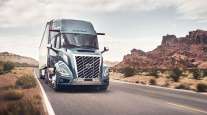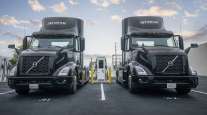Volvo, Mack Looking to Boost Sales in 2018 With New Highway Tractors

ATLANTA — Volvo Group’s North American truck brands, Volvo and Mack, are preparing for a buoyant 2018 sales climate collectively armed with three new highway tractors introduced earlier this year.
The original equipment manufacturers, both based in Greensboro, N.C., said at the North American Commercial Vehicle Show here that they expect an improving U.S. economy to lift heavy-duty sales next year after back-to-back years of industrywide declines.
NACV COVERAGE: All stories | Live blog | Photo gallery
During separate presentations Sept. 25-26, executives from the OEMs said they see opportunities for growth by moving against their historical strengths. Volvo wants to sell more regional-haul trucks while Mack wants to play in the longhaul market.
Magnus Koeck, Volvo’s marketing vice president, said now is a good time to introduce new trucks. The company rolled out its VNR regional model in April, and updated the VNL longhaul in July.
The VNR replaced the VNM model, and Koeck said the VNR holds great potential for Volvo to increase its market share.
Koeck said in an interview that VNR is “more agile and has a shorter turning radius.” He said fleets in the tank truck, bulk hauling and food-distribution sectors should be impressed with VNR.
“We got more orders for the new VNR in the six weeks after we introduced it than we got for VNMs for all of 2016,” Koeck said.
“There is a big untapped potential for us in regional haul,” Koeck said.
He added that the company needs to do a better job of educating customers on how to spec a truck. Developing specifications from the ground up is critical.
“Educating on the value of a truck when correctly spec’ed is important. We can do more on this. Things are much more complex today than before,” Koeck said.

Brandis by John Sommers II for Transport Topics
Mack showed off its new Anthem tractor and clarified how it will be marketed relative to its long-standing Pinnacle highway model that remains available.
Mack executives said that axle-back Anthem will be a highway-only model that will give the company an entry into the longhaul market, especially when purchased with a 70-inch, stand-up sleeper cab.
Pinnacle, often used in less-than-truckload and parcel transportation, now will be axle-forward only, a configuration often preferred by carriers hauling lots of weight, including tank truckers.
Anthem is designed for aerodynamic efficiency, whereas Pinnacle has a “classic look,” said John Walsh, Mack’s marketing vice president.
Roy Horton, Mack director of product strategy, said that with the advent of Anthem, Pinnacle would be intended for highway and vocational applications.
“It could be linehaul, heavy-haul or oil field services for Pinnacle, and our MP8 engine is the only option,” Horton said, referring to Mack’s 13-liter power plant.
In contrast, Anthem will have three engine choices: the 11-liter MP7, MP8 or a Cummins-Westport 12-liter natural gas model.
Mack is a big manufacturer of vocational trucks for construction and refuse hauling, but Walsh said the company has been “unfairly pigeon-holed as vocational only.”
Jonathan Randall, a senior vice president, said, “longhaul trucking is coming back,” and that Mack wants a piece of that market and will use Anthem to pursue it.
“We’re back into markets where we hadn’t been a strong consideration,” Randall said of the company’s longhaul effort.
Besides fuel-efficiency improvements, Horton said the Anthem’s design included input from drivers so as to add to their comfort. He said the tractor has 27 cubic feet of storage space throughout the cab in several locations.
The tractor was launched in Allentown, Pa., in mid-September.
Also during the Volvo presentation, the company said its engineers are trying to harness significant changes that are coming to trucking and truck making in the fields of electric, automated or connected vehicles.
Keith Brandis, VTNA director of product planning, said connected vehicles have made the most progress, but that automation and electrification still need work.
“It will take many steps,” to get to the future, Brandis said. “We’ll need many, many miles of testing. We engineers haven’t figured out all of this yet, but that’s OK.”
For the foreseeable future VTNA management sees automation as driver assistance, not replacement.
“We can’t see a world without professional truck drivers,” spokesman Brandon Borgna said. “This should not be seen as a way to remove the driver.”
Electrified trucks are coming, VTNA President Göran Nyberg said.
“We will see them first with light- and medium-duty trucks, but I still believe longhaul trucks will be based on diesel for a while,” he said.
Fuel and engine issues are changing rapidly. Earlier this decade, natural gas was seen as the savior of trucking.
Brandis said hopes for electricity have replaced natural gas and dimethyl ether, not because they are bad fuels but the world has changed.
“Electricity is coming and will be a part of [the future]. We have to place our bets as best we can,” he said.




